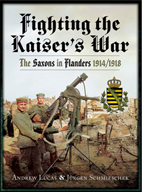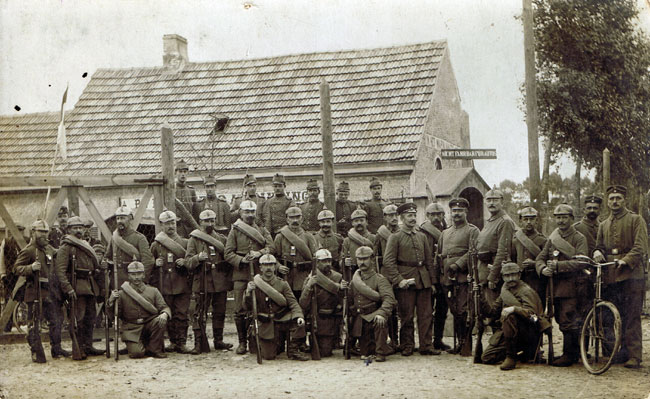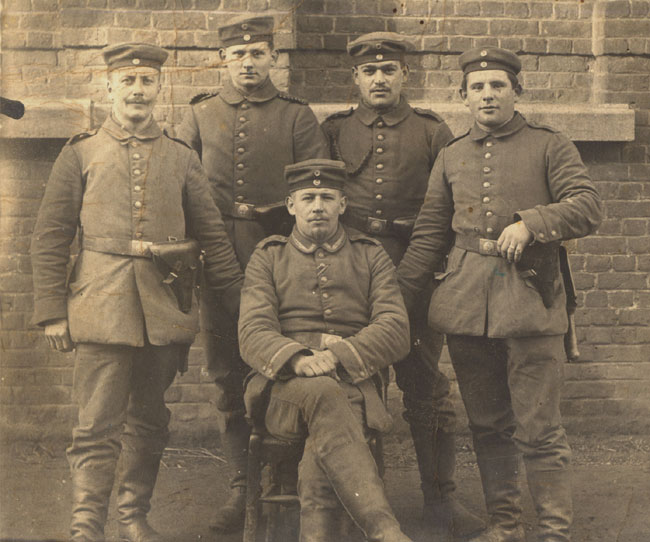On Sunday 25th April 1915 the Second Battle of Ypres was in full swing. On the XXVII. Reservekorps front 53. Reserve-Division launched local attacks near Broodseinde to hold the British in place.
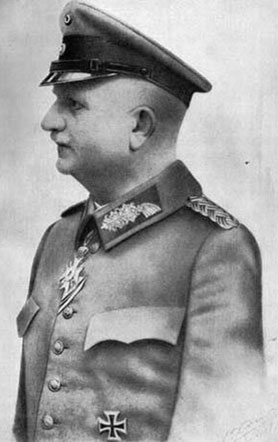
West of Passchendaele the corps reserves (including Regiment von Heygendorff) continued the drive against the northern face of the salient, which had begun with a major gas attack on the previous day. While the battle continued to rage, Generalmajor Richard Kaden (brigade commander of the mixed Saxon / Württemberg 58. Infanterie-Division) found himself at a loose end. With his troops held in OHL (supreme command) reserve in the Roubaix area since the end of March and no prospect of deployment, Kaden went on a leisurely Sunday drive as far as the XXVII.RK rear area:
I visited the grave of Achim Peter in Ledeghem, and found it handsomely cared for and located in a tranquil spot in the churchyard. I contemplated the young life which had met its end here, then drove to Roulers where I spent a most diverting hour, since a huge crowd of captured Canadians had just arrived in the marketplace via the narrow-gauge railway. They all looked very much the worse for wear. The eight officers who marched at the head of the group made a reasonable impression. At the marketplace I met the staff officer of the division, my old friend from the Kriegsakademie General von Runckel [Kdr. of 43. Res. Div.]. I briefly visited him and heard some details of the fighting which is still raging north-east of Ypres, in which von Watzdorf's Saxon division [53. Res. Div.] was also involved. When the trenches were stormed many of the enemy were captured in an insensible condition, poisoned by the gas, together with many others who gave themselves up without any resistance...
On the return journey I broke down a short distance from Courtrai. In the village in question [Lendelede] there is a Saxon Etappenfuhrparkkolonne [rear-area supply park column] under the command of Graf Schimmelmann, where I spent an hour or so. Just eight days ago the famed aviator Ltn. Garros was captured here. Flying his machine-gun armed craft alone without an observer, he had shortly before brought down a German Taube and then proceeded to drop a bomb on the railway station. To this end he had descended to a height of 600 metres, and was at that very moment spotted by men of the Landsturm, shot at and forced into a steep glide. Immediately after landing he had burned his machine and concealed himself in a ditch, where he was discovered. The French papers are greatly mourning the loss of this man, the best of their aviators, who had also made a most favourable and gentlemanly impression on Schimmelmann.

The men who shot down Garros
While not technically an ace (with only three confirmed aerial victories at this time), Sous-lieutenant Roland Garros of Escadrille MS26 had certainly presented a uniquely serious threat to German aviators.
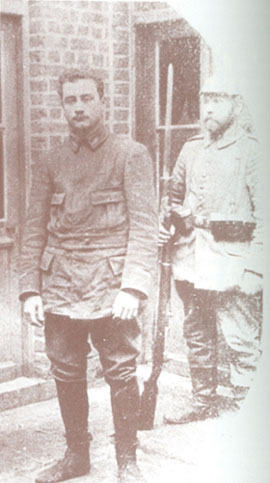
On 1st April he had achieved the first ever aerial 'kill' with a machine-gun fired forward through the propeller, using a system of deflector plates of his own design fitted to the blades. With this (at the time) unique advantage he could have been forgiven for thinking himself invincible when he attacked Lendelede railway station on the 18th.
With his engine disabled by ground fire, he made an emergency landing near Hulste and was soon run to ground by a Württemberg cavalry patrol. Although he had managed to set his aircraft on fire, the deflector device was intact enough to be salvaged and understood. It would however soon be superseded by Fokker's synchronisation gear (which far more elegantly prevented the gun from firing at the moment when the blade passed in front of it). Garros himself would eventually escape from a POW camp in February 1918 and return to action, only to be shot down and killed on 5th October 1918 after achieving a fourth and final aerial victory.
The credit for shooting down Garros was claimed by two different units, both of which would be acknowledged and rewarded. Having only had the chance to hear from one of them, Generalmajor Kaden supports the claim of 1. Kompagnie / Landsturm-Infanterie-Bataillon 'Wurzen' XIX.9. Although this is one of only two Saxon Landsturm infantry battalions with a full published history, it has remarkably little to say about what was unquestionably its most significant achievement:
The Bahnschutzwache [railway guard] Lendelede (1. Komp.) shot down the French flier Garros and took him prisoner (Feldwebelleutnant Schlenstedt, Landsturmmann Arnold I and Landsturmmann Brömme received a cash reward and the Iron Cross 2nd Class).
The other claim is more detailed and technically more credible (if less entertaining than the idea of some old Saxon militiamen downing a celebrity aviator using - presumably - a mere machine-gun). The unit in question was the Fliegerabwehrzug or Fliegerabwehrbatterie (anti-aircraft section or battery) of Reserve-Feldartillerie-Regiment Nr.54, formed at the beginning of April and commanded by Leutnant der Landwehr (later Oberleutnant) Egon Kienzle. Though it was initially based at Ledegem, Leutnant der Landwehr Prof. Karl Ramshorn of RIR 245 states (in a colourful account of his time as regimental billeting officer which appears in full in For King and Kaiser) that the well-liked Württemberg artillery officer had two guns set up near the Waterdamhoek crossroads, making him Ramshorn's close neighbour.
According to the regimental history of Oberst a.D. Klotz (Das Wurttembergische Reserve-Feldartillerie-Regiment Nr.54 im Weltkrieg 1914-1918):
Using their fast aircraft fitted with machine-guns, the enemy had shot down six of our eighteen fliers, since they only had one fighter aircraft at their disposal. On the 18th the 5. Batterie succeeded in shooting down Garros, known at the time as the most dangerous French aviator, who was then captured.
The battery located at rest in Moorsele was always required to provide one piece as an anti-aircraft gun, at the disposal of the Kommando under Oberleutnant Kienzle which was based there. Usually the entire resting battery would gather as spectators.
One evening an enemy flier unexpectedly appeared, eagerly aiming for the rear area. Immediately fire was opened and soon the plane was encircled [by shellbursts], shot after shot followed at the highest rate of fire. But all in vain, for the plane seemed invulnerable. The range grew ever greater and finally the leader's command rang out "halt, cease fire". Then "crash" another shot went off and triggered a frightful tirade from the leader about this poor fire discipline. Every possible punishment was promised. Then suddenly a gunner called: "Herr Oberleutnant, he's falling!" Everyone spun around and indeed, the last inadvertent shot had nevertheless still found its target. The flier could be seen descending in a steep glide. With the cry "a cask of beer for the whole crew tonight!" the leader left the crew to accept the somewhat contradictory judgement. When it subsequently turned out that the renowned Garros had fallen into our hands, there were even awards.
Above left: A 60cm carriage-mounted floodlight from Reserve-Scheinwerfer-Zug Nr.27 (the corps searchlight platoon of XXVII. Reservekorps) on airfield defence duty behind the front.
Above right: Saxon field artillerymen of XXVII. Reservekorps (either RFAR 53 or I. Abt. / RFAR 54) with a typical early anti-aircraft gun. A standard 7.7cm FK96 n.A. field gun has been mounted (complete with trail and wheels) on a 'Schnetzler-Sockel', a more elaborate mass-produced replacement for the first wave of improvised turntables.
In early 1915 many field artillery regiments were expected to improvise their division’s anti-aircraft defence with the weapons available to them, just as they were later expected to improvise its anti-tank defence.
Biographical note: Generalmajor Richard Kaden
Richard Kaden was born on 7th March 1862 in Dresden, evidently into a military family (since his younger brother Alfred also became a senior Saxon officer). Richard joined Kgl. Sächs. 2. Grenadier-Regiment Kaiser Wilhelm, König von Preußen Nr. 101 (GR 101) as an Avantageur on 1st December 1879 and was commissioned as a Leutnant in 1881. His subsequent career included posts with several Saxon infantry regiments, the general staff and the Kriegsministerium in Dresden. On 23rd September 1911 he was promoted to Oberst and given command of Kgl. Sächs. 11. Infanterie-Regiment Nr. 139 (IR 139) in Döbeln. Kaden would always maintain a special affection for this regiment, but would never command it in battle due to his elevation to the Generalität (the class of general officers) on 20th April 1914.
Now holding the rank of Generalmajor and command of 48. Infanterie-Brigade (IR 106 and 107) within 24. Infanterie-Division, Kaden took part in the invasion and the First Battle of the Marne that summer. When the bulk of XIX. Armeekorps were sent north to attack Lille, his brigade initially remained on the Champagne front in reserve. Rushed north on 22nd October 1914 during the First Battle of Ypres, IR 106 and 107 were thrown into the XIX.AK front at Ploegsteert Wood and La Houssoie respectively.
They were still there at Christmas, and 'Fighting the Kaiser's War' includes his remarkable and revealing description of the truce (to our knowledge, he is the highest ranking officer of the corps to have left a surviving account of this remarkable event). Please refer to my Christmas Truce article for further information.
In early 1915 the divisions of XIX.AK were among those chosen for what English-speaking authors have termed 'triangularisation' - reduction from four infantry regiments each (organised into two brigades) down to three (organised into a single brigade). Alongside the ongoing reduction of field artillery batteries from six to four guns, and a still greater reduction in divisional cavalry, this measure allowed the rapid creation of a whole wave of new divisions. The practical result for Generalmajor Kaden was that on 4th March 1915, he and his staff were suddenly ordered to be in Cambrai two days later. Within a week they had been joined by their troops - IR 106, IR 107 and Württemberg Reserve-Infanterie-Regiment 120 (from the 'triangularisation' of 26. Reserve-Division). Kaden's command was henceforth 116. Infanterie-Brigade of 58. Infanterie-Division, the second and arguably the most successful of the three mixed Saxon / Württemberg divisions.
Under Kaden's command the brigade fought with distinction at Vimy Ridge in May-June and in the victorious German campaign in the east from July to October 1915. His last campaign was Verdun in March–April 1916. For three hellish weeks, the brigade struggled to hold and advance the front through the blockhouse-studded Caillettewald (Bois de la Caillette) towards Fleury, in the teeth of the heaviest artillery fire the French Army could muster and a relentless series of counter-attacks. According to Sachsen in großer Zeit this ordeal cost the division an estimated total of 507 dead (including nineteen officers), 2,391 wounded (including fifty-five officers) and 165 missing (including one officer); a further 2,648 were reported sick. On the very first day, Kaden's brigade HQ dugout was partially demolished by a direct hit from heavy artillery, killing or maiming some of his closest colleagues. He was thus in no mood to be diplomatic in criticising the use made of his brigade (or the wider conduct of the battle), and evidently made some enemies among the Falkenhayn faction, who had staked everything on the Verdun campaign.
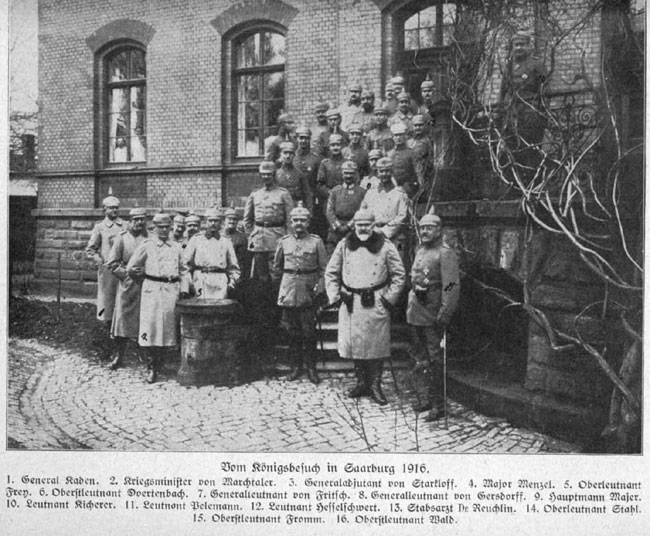
Writing in 1933 Kaden declined to name his opponents, but made it clear that he was 'pushed' out of his post. Privately informed that he could not expect to become a divisional commander, he took the implied offer of an honourable retirement and tendered his resignation. This was sweetened on 27th April 1916 by the award of the Komturkreuz 2. Klasse of the Militär-St.Heinrichs-Orden, with a citation praising his leadership of the brigade in battle under exceptionally difficult conditions.
On the semi-retired (zur Disposition) list from 11th August, he was given the home-front command of Stellvertretende 89. Infanterie-Brigade in Zwickau in November 1916. On 17 June 1918 he was charakterisiert (granted an honorary promotion) to the rank of Generalleutnant. He finally left what was now the Reichswehr of the Weimar Republic in 1920 after over forty years of military service, and died in 1948.
All three of Kaden's sons fought as Saxon officers during the war, and only one survived. Leutnant Hellmuth Kaden was cut down by French machine-guns at La Salle on 7 September 1914, while serving as adjutant and acting battery commander with the Mobile Ersatz-Abteilung / Feldartillerie-Regiment 77 (a provisional battalion-sized unit belonging to 19.Ersatz-Division). In a particularly harsh blow Leutnant der Reserve Hans Kaden was serving with his father's beloved IR 139 when he too was killed in action at L'Epinette in June 1916. The fate of the general's third son, Leutnant Gert Kaden, was not so tragic but nevertheless a source of great anxiety for his family. In peacetime a subaltern with the MG-Kompagnie of IR 103, Gert was serving in the field with Ersatz-Infanterie-Regiment 23 (again, with 19. Ersatz-Division) when in late 1915 he tried to arrange a transfer to the cavalry – evidently without consulting his father. For unknown reasons, this highly unusual request resulted in a protracted and complex case before the military courts, and Gert's eventual discharge from the Royal Saxon officers' corps.
Our primary source for the selection of diary entries in Fighting the Kaiser's War (covering the First Battle of Ypres, Christmas Truce and formation of 58. Inf. Div.) is an original hand-annotated typescript of Generalmajor Kaden's journal. Occasional comments suggest later revision with the benefit of hindsight, the extent of which can only be guessed at. Portions of the journal were included in Kaden's published autobiography In der Alten Armee (1933), but as a rule stripped of all references to family matters and (potentially libellous) criticisms of named officers.

